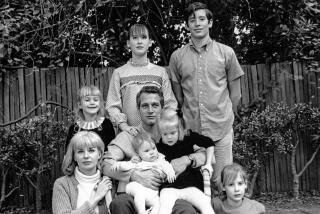Book Review : Examining Roles of Maids, Employers
Between Women: Domestics and Their Employers by Judith Rollins (Temple University Press: $24.95)
Though “provocative” and “tempting” aren’t usually criteria for choosing a dissertation topic, the relationship between domestic workers and their employers promises more excitement than most. With any luck at all, the subject should be fraught with enviable opportunities for ironic social commentary, especially if the writer actually does some field research with mop and bucket as a domestic herself.
Conforming to standard academic practices, Rollins states her intent in the introduction. “How class and race inform this female-female work relationship and the meaning of the relationship both to the women involved and to the larger society are the central issues to be addressed.” Meeting the challenges head on, the author not only took 10 different household jobs, but read extensive literature on the history of domestic service throughout the world, arranged interviews with 20 domestics and their employers, observed actual maids at work by posing as their visiting cousin, and conducted a three-hour discussion with six women who had worked in households for long periods of time.
She also visited employment agencies, spoke at length to the daughter of a life-long domestic employee and interviewed a young man who had been brought up by family retainers. Once this research machinery was in place, Rollins had every reason to expect that a stark picture of exploitation on the one hand and resentment on the other would emerge, dramatized by the radically different perceptions of mistress and servant towards one another.
This was not to be precisely the case, for a number of reasons beyond the writer’s control. Though the 20 employers who volunteered for the study ranged in age from 29 to 76, all were college-educated Bostonians; 15 holding master’s degrees, three doctorates. Except for the two widows, all had incomes between $40,000 and $100,000 a year. Eleven of these women worked full time at their professions, two worked part time, two had new babies and two were retired.
Aside from the widows, every one of Rollin’s interviewees was currently married. Could you call them typical? Rather wistfully, Rollins agrees she could not, quickly perceiving that people who volunteer to assist a sociologist in her work tend to have little in common with Simon Legree.
The author had slightly better luck with the domestics, several of whom allowed themselves some tart comments about unrealistic expectations, antiquated equipment or excessive workloads, but none of them seemed to be seething with rage or hostility. Like the employers, the domestics tried to be understanding and generous.
Variations on a theme of “nobody’s perfect” turn up in the quotes from both sides. A few household employees actually sounded enthusiastic about their jobs, mentioning the independence, the opportunity to set their own pace and schedule; one woman even recommending housework as healthful exercise with great benefits to the figure. More frustrating still, the respondents had relatively little to say on the subject of wages, an area where the maximum amount of discord should have surfaced.
Even Rollins’ personal experiences as a maid seemed to fall short of her anticipations. Except for one employer, who thought the author seemed curiously overqualified for the job and perhaps a bit too elegantly turned out, her “ladies” seemed an easy-going lot, neither rude nor unreasonable; no more capricious or temperamental than any other sort of employer.
Understandably frustrated by the current situation, the author is thrust back upon history, where outrages abounded. There she uncovered an embarrassment of horrors that happily no longer remain in the academic enclaves of Greater Boston. There at least, the connection between domestics and those who engage them no longer seems to function as it once did “to support the class, gender and racial hierarchies of this country.” Blandly disconcerting findings, but welcome news all the same.
More to Read
Sign up for our Book Club newsletter
Get the latest news, events and more from the Los Angeles Times Book Club, and help us get L.A. reading and talking.
You may occasionally receive promotional content from the Los Angeles Times.









